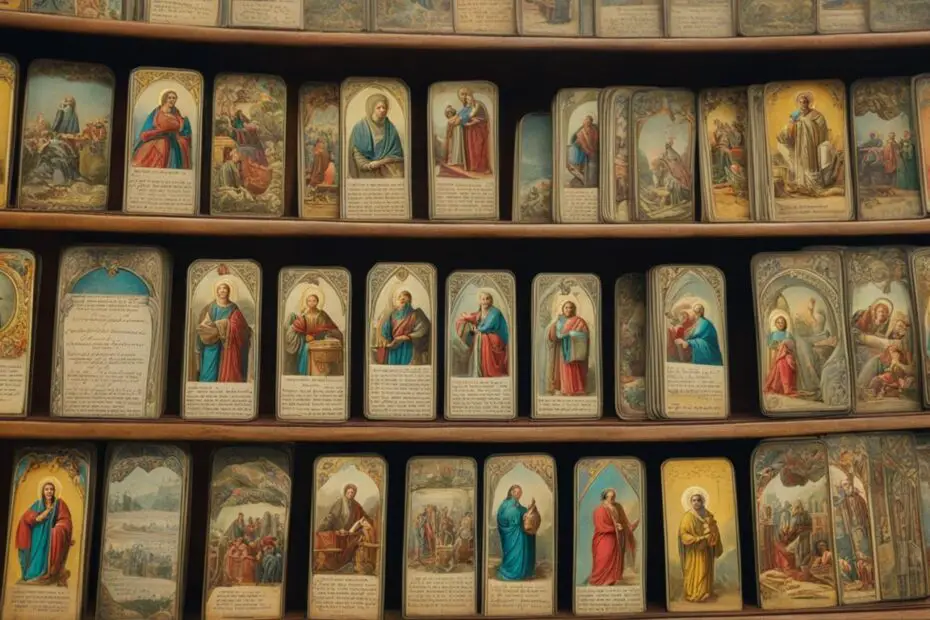Prayer cards, also known as holy cards, have a rich history that dates back to the 15th century. These devotional items were originally used to assist in prayer and were often hand-made. They have since evolved into small cards depicting religious scenes or saints, with prayers on the reverse side. Prayer cards have deep roots in Catholic tradition and continue to play a significant role in personal devotion and spiritual practice.
Key Takeaways:
- Prayer cards have a history that dates back to the 15th century.
- They were originally used as aids in prayer.
- Prayer cards have evolved into small cards depicting religious scenes or saints.
- They serve as tangible reminders of one’s faith and can deepen the connection with the divine.
- Prayer cards continue to be significant in personal devotion and communal worship.
The Evolution of Prayer Cards
Throughout history, prayer cards have undergone a remarkable evolution, adapting to the changing needs and preferences of individuals seeking spiritual connection and guidance. What began as simple handmade cards has now transformed into a vast array of designs and themes, reflecting the diversity of prayer practices and personal beliefs. Let’s explore the fascinating journey of prayer cards through the ages, delving into their historical development and significant milestones.
Prayer cards first emerged as humble artifacts during the Middle Ages, primarily as keepsakes for pilgrims visiting shrines. These early cards were crafted by devoted individuals, often featuring hand-drawn illustrations of saints or religious scenes. However, it was during the 17th to 19th centuries that prayer cards saw a true renaissance in their production and popularity.
One major turning point in the evolution of prayer cards was the advent of chromolithography, a printing technique that allowed for mass production and vibrant, detailed designs. This innovation resulted in beautifully crafted cards that captured the hearts of believers worldwide. The golden age of prayer cards had begun.
“Prayer cards, through their visually captivating designs and intimate connection to the divine, have become cherished companions in the spiritual journeys of individuals.”
Prayer Cards Adapt to Reflect Occasions and Intentions
As prayer cards gained popularity, they began to adapt to different occasions and intentions, catering to the specific needs and preferences of believers. Today, you can find a wide variety of prayer cards for various purposes, ranging from saint prayer cards to guardian angel cards, holy family cards, and more.
These specialized prayer cards offer devotees the opportunity to seek intercession or find solace in the presence of specific spiritual figures. Whether one is praying for healing, guidance, or protection, there is a prayer card to represent and embody those intentions.
“The evolution of prayer cards has allowed individuals to choose cards that resonate with their needs, fostering a deeper connection with their spiritual beliefs and intentions.”
Prayer Cards as Gateways to Spiritual Inspiration
As prayer cards evolved and became more accessible, they also became powerful tools for spiritual inspiration. The images and prayers depicted on prayer cards serve as gateways to deeper reflection, providing visual aids that guide and focus prayers.
With their intimate connection to the divine, prayer cards have the ability to awaken feelings of gratitude, hope, compassion, and forgiveness within individuals. These emotions contribute to a sense of inner peace and well-being, infusing spiritual practice with a profound sense of purpose and connection.
“By incorporating prayer cards into their daily routines, individuals find dedicated moments for prayer and reflection, nurturing their faith and strengthening their relationship with the divine.”
Prayer Cards: A Testament to the Power of Visual Representation
The enduring popularity of prayer cards can be attributed to their ability to provide a tangible representation of one’s spiritual beliefs. These cards serve as physical reminders of faith, fostering a sense of connection between the material world and the divine realms.
Beyond their personal significance, prayer cards also play a significant role in communal worship. They are often shared during religious events or ceremonies, uniting believers in their collective devotion, and enhancing the sense of community. In this way, prayer cards contribute to the rich tapestry of communal worship, strengthening the bond between individuals and their shared faith experiences.
“Prayer cards, with their visual splendor and symbolic meaning, serve as powerful conduits for believers, connecting them to their spirituality and inspiring their journeys of faith.”
As the evolution of prayer cards continues, these cherished devotional items remain beloved companions on the spiritual journeys of individuals. They serve as timeless reminders of faith and devotion, embodying the rich history and profound significance of prayer cards in the realm of Catholic devotion.
<!– Table preview:
| Time Period | Significant Milestones |
|---|---|
| 15th century | Origins of handmade prayer cards |
| 17th-19th centuries | The golden age of prayer cards with the advent of chromolithography |
| Modern times | The revival of prayer cards among private collectors |
–>
Significance of Prayer Cards
Prayer cards hold great significance in the lives of Catholics. They serve as visual aids and tangible reminders of one’s faith. When held in one’s hands or displayed in a sacred space, prayer cards create a physical connection between the individual and their spiritual beliefs.
Prayer cards play a crucial role in guiding and focusing prayers. They often feature prayers or specific invocations, leading the faithful in their spiritual practice. These cards serve as a source of comfort during times of distress, providing solace and reminding individuals of the divine love and mercy that is always present.
Furthermore, prayer cards have the power to inspire and uplift. The images and words printed on these cards depict saints, religious scenes, or holy figures, evoking a sense of reverence and awe. As one gazes upon these devotional images, they are reminded of the sacredness and beauty of their faith.
The importance of prayer cards extends beyond personal devotion. They foster a sense of community and shared devotion when passed on or shared during communal worship or religious events. When members of a community come together and hold prayer cards, they unite their intentions and lift their voices in a collective expression of faith.
Prayer cards also serve as a physical representation of one’s spiritual journey. They become cherished keepsakes that capture significant moments of personal growth and reflection. Whether it is a card received during a pilgrimage, a gift from a loved one, or a memento from a religious celebration, prayer cards hold sentimental value and become cherished symbols of faith.
The Significance of Prayer Cards:
- Visual aids and tangible reminders: Prayer cards create a physical connection to one’s faith.
- Guiding and focusing prayers: Prayer cards feature prayers and invocations, serving as guides in spiritual practice.
- Comfort and inspiration: The images and words on prayer cards provide solace and inspire devotion.
- Community and shared devotion: Prayer cards foster a sense of unity and shared faith during communal worship.
- Physical representation of spiritual journey: Prayer cards become cherished keepsakes, capturing moments of personal growth and reflection.
With their visual impact, comforting words, and ability to foster community and connection, prayer cards continue to hold immense significance in the spiritual lives of Catholics.
Examples of Popular Prayer Card Themes
| Theme | Description |
|---|---|
| Saint Prayer Cards | Featuring individual saints and their intercessory power |
| Guardian Angel Cards | Highlighting the presence and protection of guardian angels |
| Holy Family Cards | Depicting the Holy Family of Jesus, Mary, and Joseph |
| Divine Mercy Cards | Emphasizing the boundless mercy of God |
| Cross and Crucifix Cards | Symbolizing the sacrifice and redemption of Jesus Christ |
The Benefits of Using Prayer Cards
Using prayer cards offers numerous benefits for individuals seeking to enhance their spiritual practice. Prayer cards can foster a sense of spiritual alignment with God, bringing forth feelings of gratitude, hope, compassion, and forgiveness. These positive emotions contribute to a sense of inner peace and well-being. Incorporating prayer cards into daily routines allows for dedicated time for prayer and reflection, nurturing one’s faith and relationship with God.
“Prayer is not asking. It is a longing of the soul. It is daily admission of one’s weakness. It is better in prayer to have a heart without words than words without a heart.” – Mahatma Gandhi
Deepening the Spiritual Connection
Prayer cards serve as powerful visual aids that deepen the spiritual connection with God. Amidst the distractions of everyday life, prayer cards provide a tangible representation of the divine, reminding individuals to pause and turn their hearts towards prayer. The deliberate act of holding a prayer card and meditating on its sacred image or words can create a sacred space within, enabling a deeper communion with the divine presence.
Guiding and Focusing Prayer
Prayer cards act as guideposts in the practice of prayer, offering structured prayers or words of devotion that can help individuals stay focused and centered. Whether reciting a specific prayer or reflecting on the virtues of a saint depicted on the card, prayer cards provide a framework that inspires a more profound connection with the divine. By offering direction and guidance, prayer cards help individuals approach prayer with intention and reverence.
Cultivating a Daily Ritual
Integrating prayer cards into daily routines establishes a sacred ritual that cultivates a deeper sense of spirituality and faith. Whether it’s starting the day with a moment of prayer, carrying a prayer card in a pocket or purse, or placing a prayer card on a bedside table, incorporating these devotional items into daily life encourages a consistent and dedicated practice of connecting with God. This regularity fosters spiritual growth and creates a meaningful anchor in the midst of life’s challenges.
Encouraging Reflection and Contemplation
Prayer cards provide a visual cue for reflection and contemplation, inviting individuals to pause, meditate, and delve deeper into their spiritual journey. By gazing at the image on a prayer card or reading the heartfelt words of a prayer, individuals can enter into a state of quiet contemplation, opening themselves to divine wisdom and guidance. This intentional reflection nurtures spiritual insights, strengthens self-awareness, and fosters personal growth.
A Symbol of Faith and Hope
Carrying a prayer card or placing it in a prominent location serves as a constant reminder of one’s faith and hope. In times of difficulty or uncertainty, prayer cards provide solace, reminding individuals of the enduring presence of God in their lives. The visual representation of sacred images and prayers on these cards instills a sense of assurance and provides a tangible source of comfort and strength.
| Benefits of Using Prayer Cards |
|---|
| Deepens spiritual alignment with God |
| Fosters gratitude, hope, compassion, and forgiveness |
| Creates a sense of inner peace and well-being |
| Guides and focuses prayer |
| Cultivates a daily ritual of prayer and reflection |
| Encourages deep contemplation and self-reflection |
| Serves as a symbol of faith and hope |
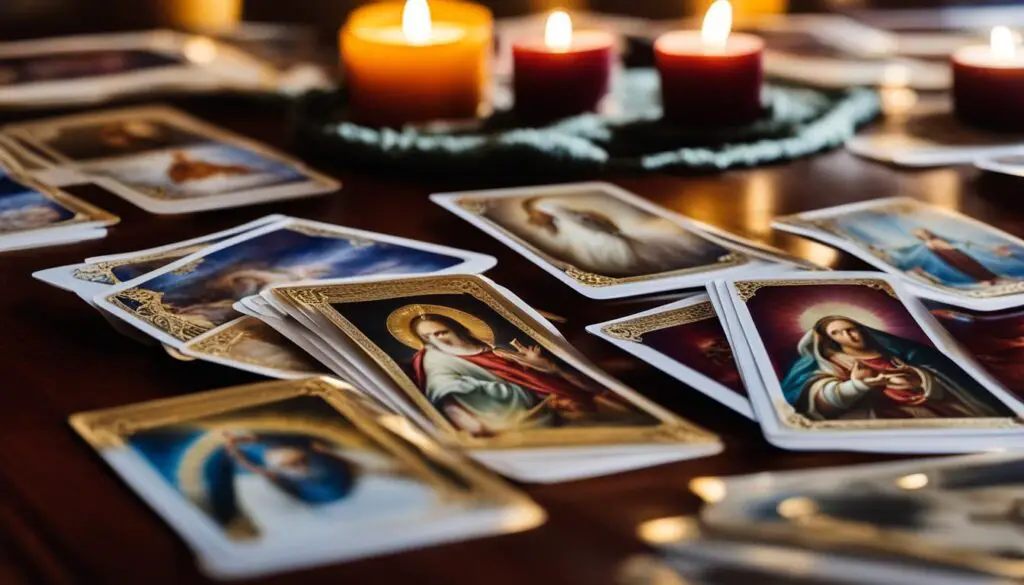
Prayer Cards in Communal Worship
In the realm of communal worship, prayer cards assume a pivotal role, uniting individuals in prayer for specific causes and intentions. Whether supported by the recitation of the rosary, litanies, or classroom prayers, prayer cards serve to concentrate and focus collective prayers. Frequently distributed during religious events or ceremonies, these cards guide and harmonize the devotions of numerous attending devotees.
Communal worship is a sacred space where believers partake in shared faith experiences, collectively strengthening their relationship with God. It is in these gatherings that prayer cards bring profound meaning, connecting worshippers on a profound spiritual level.
To visualize the significance of prayer cards in the context of communal worship, imagine a congregation coming together to fervently offer prayers for peace and unity. Each person holds a prayer card, its imagery inspiring thoughts of harmony and compassion. As the prayers resound throughout the sacred space, the collective presence of prayer cards amplifies the devotion, reinforcing the shared purpose and creating an atmosphere of deep spiritual connection.
Communal worship is a testament to the power of shared faith experiences, and prayer cards serve to enhance and unify the devotions of a gathering, strengthening the bond with God.
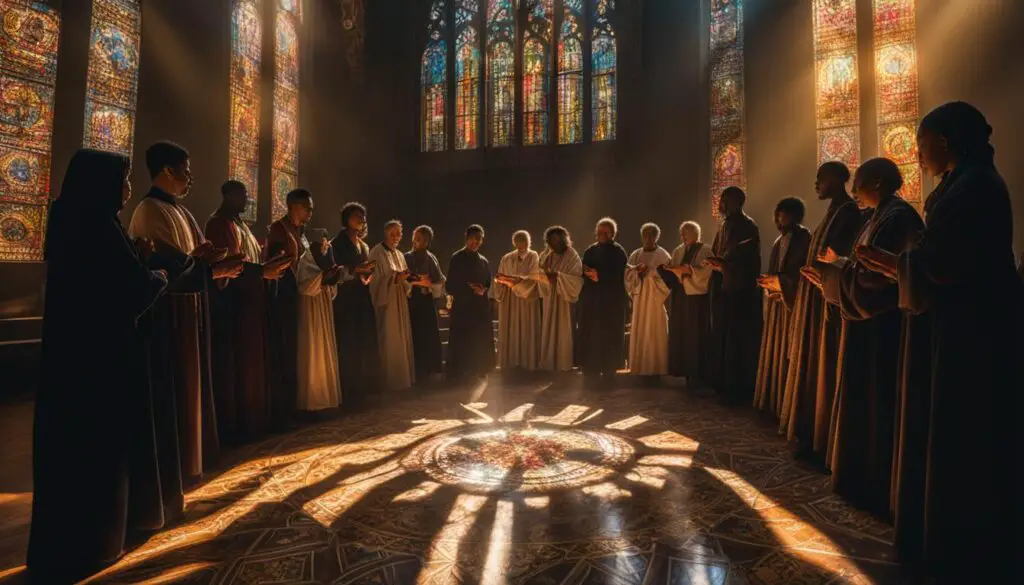
Popular Saints and Holy Figures on Prayer Cards
Prayer cards are not only cherished for their spiritual significance, but also for featuring popular saints and holy figures that hold special significance in Catholicism. These prayer cards serve as a visual representation of devotion and provide a source of inspiration and intercession for Catholics worldwide.
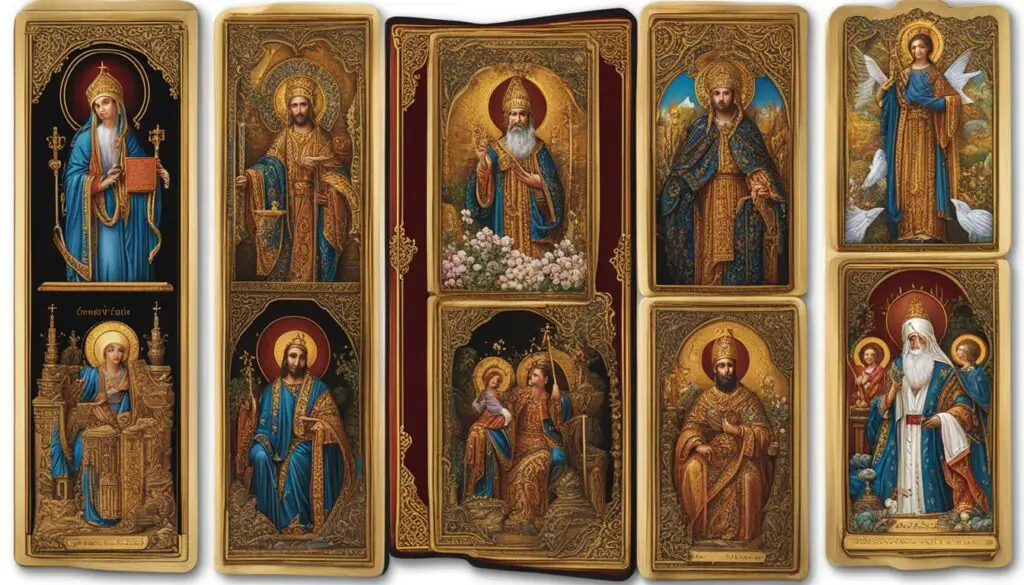
On a prayer card, you may often find depictions of Jesus Christ, the central figure of Christianity, whose life, teachings, and sacrifice serve as the foundation of the faith. The prayer cards featuring Jesus Christ provide a powerful reminder of His love, mercy, and the ultimate sacrifice He made for humanity.
The prayer cards also frequently showcase the Virgin Mary, the mother of Jesus. As one of the most revered saints in Catholicism, the Virgin Mary symbolizes purity, love, and unwavering faith. Prayer cards featuring the Virgin Mary offer solace and inspire devotion to her as an intercessor.
St. Joseph, the earthly father of Jesus and the patron saint of workers and fathers, is another popular figure seen on prayer cards. Catholics turn to St. Joseph for guidance, protection, and assistance in their personal and professional lives.
St. Francis of Assisi, known for his humility, commitment to poverty, and love for nature, is often depicted on prayer cards. His prayer cards serve as a reminder of the importance of living a simple and compassionate life.
St. Jude, the patron saint of desperate causes and lost causes, is another holy figure commonly found on prayer cards. Many people turn to St. Jude for help in times of great need and find comfort and hope through his intercession.
These popular saints and holy figures portrayed on prayer cards offer a connection to the divine, providing solace, guidance, and inspiration. They serve as a reminder of the miracles associated with their lives and their enduring faith, offering a source of strength and comfort to those who seek their intercession.
The Historical Background of Prayer Cards
The historical background of prayer cards can be traced back to the Middle Ages, where they were originally sold as keepsakes for pilgrims visiting shrines. These early prayer cards were simple and handcrafted, often featuring images of saints or religious icons.
One of the oldest surviving holy cards dates back to 1423 and depicts a woodcut image of St. Christopher. This card is a testament to the long-standing tradition of using prayer cards as aids to devotion.
During the 17th and 19th centuries, skilled engravers began producing prayer cards on a larger scale, making them more widely available. This period marked the golden age of prayer cards, characterized by the use of chromolithography, a technique that created vibrant and beautifully designed cards.
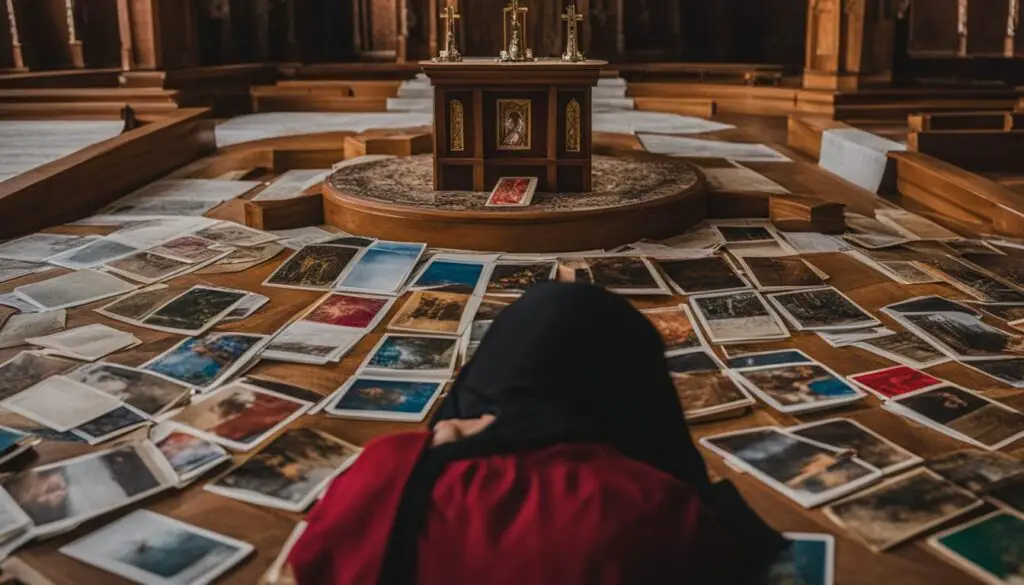
Though the popularity of prayer cards has declined in modern times, they have experienced a revival among private collectors who appreciate their historical and artistic value.
Holy Cards as Collectibles
Holy cards have transcended their religious significance and become highly sought-after collectibles among enthusiasts. These beautiful cards, often dating back to the 19th century, offer a fascinating glimpse into the artistry and religious practices of the past. Antique holy cards featuring chromolithography, a printing technique that creates vibrant and detailed images, hold particular value among collectors.
Collectors of holy cards are drawn to the uniqueness and rarity of these items. They search for cards depicting lesser-known saints or featuring intricate handwork, adding to the allure of their collections. Each card holds a story and represents a piece of religious history, making it all the more captivating for collectors.
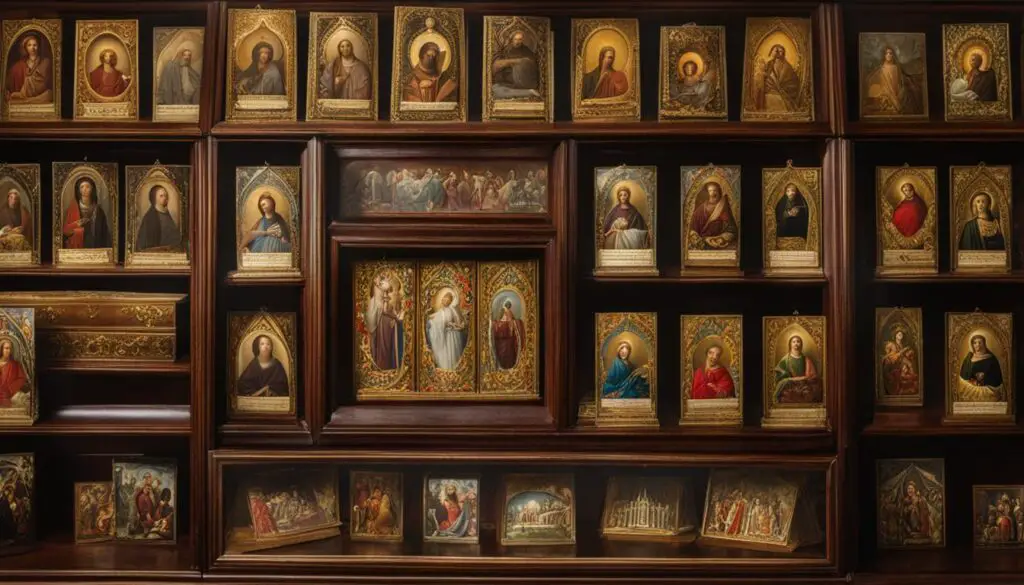
The renewed interest in holy cards has led to exhibits and sales of reproductions, making them more accessible to enthusiasts. This resurgence in popularity has created a vibrant community of collectors who appreciate the beauty, history, and spiritual significance of these unique artifacts.
| Reasons to Collect Holy Cards |
|---|
| 1. Preservation of Religious History |
| 2. Appreciation of Art and Design |
| 3. Connection to Spiritual Tradition |
| 4. Exploration of Different Saints and Devotions |
| 5. Personal Connection and Reflection |
Collecting holy cards not only satisfies the desire for unique and meaningful artifacts but also provides a way to connect with the rich spiritual traditions of the past. Through these collectibles, enthusiasts can celebrate the artistry, devotional practices, and diverse saints associated with the Catholic faith.
Holy Cards in the Modern World
Despite the decline in popularity post-Vatican II, holy cards continue to hold a significant place in contemporary Catholic devotional life. These sacred artifacts are cherished by individuals who seek solace and inspiration in their visual representation of faith. Devotees find comfort in gazing upon the images of saints and holy figures depicted on these cards, as they serve as tangible reminders of their spiritual beliefs.
Thanks to the advent of online platforms, such as eBay, buying and selling holy cards has become easier than ever before. Collectors can explore a vast array of options and add to their collections with just a few clicks. The internet has also played a crucial role in widening the availability of reproductions, making holy cards accessible to a larger audience.
Moreover, the modern era has sparked a renewed interest in the historical significance of holy cards. Enthusiasts can now delve into the fascinating stories and artistry behind these devotional items, further enhancing their understanding and appreciation. The internet serves as a gateway to exploring the rich heritage of holy cards, fostering a deeper connection with the traditions of the Catholic faith.
Expert Insights: The Significance of Holy Cards in the Digital Age
“In an increasingly digitized world, holy cards offer a tangible connection to our faith. They remind us of the saints who have gone before us, the intercession we can seek from them, and the hope they inspire. Holy cards also serve as symbols of continuity, linking us to generations of believers who have found solace and strength in their prayers. In an ever-changing world, these cards provide a sense of stability and grounding.”
As technology continues to shape our lives, the enduring significance of holy cards reminds us of the timeless nature of our spiritual journey. They serve as a bridge between the ancient traditions of Catholicism and the modern world, offering a tangible expression of faith in the digital age.
The Evolving Role of Holy Cards in Personal Devotion
While holy cards have adapted to the modern world, their core purpose remains unchanged: to deepen one’s personal devotion and connection with the divine. These small, tangible objects have the power to transform daily routines into moments of spiritual reflection and prayer.
Here are some ways in which individuals incorporate holy cards into their modern devotional practices:
- Displaying holy cards on home altars or prayer spaces, creating a sacred ambiance that fosters a sense of tranquility and reverence.
- Carrying holy cards in wallets or purses, serving as portable reminders of one’s faith and offering comfort during challenging times.
- Including holy cards in gift-giving, as a way to share blessings, prayers, and inspiration with loved ones on special occasions.
- Using holy cards as bookmarks in religious texts or journals, turning every page into an opportunity for prayer and spiritual reflection.
As the world continues to change, holy cards remain a steadfast companion on the spiritual journey, offering comfort, guidance, and a tangible connection to the divine.
| Holy Card Usage in the Modern World | Benefits |
|---|---|
| Displaying holy cards in homes and personal spaces | Creates a sacred atmosphere for prayer and reflection |
| Carrying holy cards as personal talismans | Offers comfort and inspiration in daily life |
| Including holy cards in gift-giving | Shares blessings, prayers, and inspiration with loved ones |
| Using holy cards as bookmarks | Transforms reading and writing into acts of devotion |
The Lasting Legacy of Prayer Cards
Prayer cards hold a sacred place in the hearts of Catholics and have left a lasting legacy in the realm of devotional practices. These cherished cards serve as tangible reminders of one’s faith, keeping alive the traditions and teachings of the Catholic Church. With their artistry and beauty, prayer cards have captivated individuals for centuries, leaving an indelible mark on the history of Catholicism.
As keepsakes of faith, prayer cards provide comfort and inspiration to believers. Each card is a visual representation of a beloved spiritual figure, whether it’s Jesus Christ, the Virgin Mary, or a revered saint. These symbolic images serve as a window to the divine, fostering a deep connection with God and encouraging personal devotion and prayer.
Prayer cards also play a vital role in Catholic culture, passed down from generation to generation. They become treasured heirlooms, reminding families of their spiritual heritage and the values they hold dear. In times of joy or sorrow, these cards are often turned to for solace, guidance, and intercession.
Furthermore, the historical significance of prayer cards cannot be overlooked. They have been witness to the evolution of Catholic devotional practices throughout the centuries. From the humble beginnings of handmade cards to the widespread availability of printed versions, prayer cards have adapted with the changing times while maintaining their spiritual significance.
Today, as interest in holy cards persists, prayer cards continue to endure as a tangible expression of faith. They carry the legacy of generations past and connect individuals to the rich traditions and teachings of Catholicism. Whether kept as personal keepsakes, shared with loved ones during religious milestones, or used in communal worship, prayer cards remain an integral part of the Catholic experience.
Conclusion: A Rich and Enduring Legacy
Prayer cards have a captivating history that spans centuries, evolving from humble handmade aids to widely cherished devotional items. These cards hold significant meaning for individuals seeking spiritual connection and guidance. Throughout the years, prayer cards have played a pivotal role in personal devotion, communal worship, and the cultural fabric of Catholicism.
Despite fluctuations in popularity, the legacy of prayer cards remains unyielding. As tangible reminders of faith, they continue to captivate and inspire. By visually representing cherished figures and sacred scenes, prayer cards provide comfort, guidance, and a tangible connection to divinity.
As the world embraces digital advancements, prayer cards have found a place in the modern era. Collectors seek out vintage cards depicting intricate artwork and lesser-known saints, while online platforms make reproductions more accessible. The internet has opened up new avenues for exploration, distribution, and preservation of prayer cards, ensuring their historical significance endures.
In conclusion, the history of prayer cards is a testament to the enduring power of personal devotion and the human yearning for spiritual connection. These small but significant cards have left an indelible mark on the cultural and religious tapestry of Catholicism, serving as visual aids for prayer, symbols of faith, and tangible expressions of devotion. Prayer cards continue to enrich the lives of believers, inspiring and guiding them on their spiritual journeys.
FAQ
What is the history of prayer cards?
Prayer cards, also known as holy cards, have a rich history that dates back to the 15th century. They were originally used to assist in prayer and often hand-made.
How have prayer cards evolved over the years?
Prayer cards have evolved from simple handmade cards into widely available cards depicting religious scenes or saints, with prayers on the reverse side. They now come in various designs and themes.
What is the significance of prayer cards?
Prayer cards serve as visual aids and tangible reminders of one’s faith. They help guide and focus prayers, provide comfort and inspiration, deepen the connection with the divine, and foster a sense of community.
What are the benefits of using prayer cards?
Using prayer cards fosters a sense of spiritual alignment, gratitude, hope, compassion, and forgiveness. They contribute to inner peace and well-being, nurture faith and relationship with God, and provide dedicated time for prayer and reflection.
How do prayer cards play a role in communal worship?
Prayer cards assist in focusing collective prayers during communal worship, such as the recitation of the rosary or litanies. They are often distributed during religious events or ceremonies to guide and unify the prayers of a large number of devotees.
Who are some popular saints and holy figures featured on prayer cards?
Popular saints and holy figures depicted on prayer cards include Jesus Christ, Virgin Mary, St. Joseph, St. Francis of Assisi, and St. Jude, among others. These figures provide inspiration and intercession.
What is the historical background of prayer cards?
The historical background of prayer cards traces back to the Middle Ages, where they were sold as keepsakes for pilgrims. The oldest surviving holy card is a woodcut image of St. Christopher from 1423.
Are holy cards considered collectibles?
Yes, holy cards, particularly antique ones from the 19th century featuring chromolithography, are sought-after collectibles. They offer insights into art and religious practices of the past.
How are prayer cards used in the modern world?
Prayer cards continue to have a place in contemporary Catholic devotional life. They are cherished by individuals who find solace and inspiration in their visual representation of faith. Online platforms facilitate buying and selling among collectors.
What is the lasting legacy of prayer cards?
Prayer cards serve as keepsakes of faith, reminders of spiritual figures, and tools for personal devotion and prayer. They have left an indelible mark on the history of Catholicism and continue to captivate and inspire individuals.


